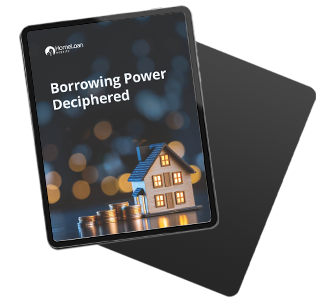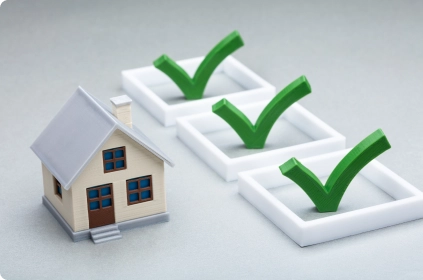Borrowing Capacity Formula
The basic formula banks use to calculate borrowing power is as follows:
Gross income – (tax+existing commitments+new commitments+living expenses+buffer) = monthly surplus
For example, if you have, each month:
- $10,000 income
- $2000 taxes
- $500 credit-card payments
- $3000 proposed home loan repayment
- $2000 living expenses
- $500 buffer applied by the bank
The bank will calculate your monthly surplus this way:
$10,000 – ($2,000+ $500+$3000+$2,000+$500)
$10,000 – ($8,000) = $2,000
With a monthly surplus of $2000 on a loan repayment of $3,000, you would pass the lender’s serviceability calculator. But it’s not that simple. Read below to find out how each of the elements in this formula is calculated.
The 360° Home Loan Assessor empowers you to assess your borrowing capacity with ease and accuracy. Our tool takes into account various factors, such as your income, expenses, and financial commitments, to provide a comprehensive analysis of your borrowing power, helping you make informed decisions.
Gross Income
There are a number of income sources that banks will consider when calculating your gross income. These include:
- Base income: All lenders accept all of your base income in their assessment. It’s the only income type that the banks all agree should count in full.
- Overtime: Some banks will accept 100% of your overtime income if overtime can be shown to be regular and ongoing. Other banks will accept only half of overtime income for assessment purposes.
- Bonuses: Bonuses are often irregular so lenders normally ask for a two-year history or will not accept all of your bonus income.
- Commissions: Some lenders accept commission as a form of income if it has been received for at least one or two years. They are looking to see if your commission income is regular and ongoing.
- Tax-free income: Family Tax Benefits A &B are normally accepted if your children are under 11 years old. Other tax-free income is assessed case by case.
- Rent: Rental income from investment properties is an accepted form of income; however, lenders typically accept just 80% of the rental income that you receive, to account for costs such as property management, repairs and council rates.
Before You Buy: The Importance of Borrowing Power
The Secrets Of Borrowing Power And Maximising Your Mortgage Potential

Tax / Medicare
You may notice that different lenders assess your tax expenses differently.
This is because there are often errors in the ways that the banks calculate your tax. We’ve copied these errors in our calculators to ensure that our result matches those of the banks.
Existing Commitments
Banks consider many expenses part of your existing commitments. These include:
- Existing mortgages: Some lenders use the actual repayments for your loans, whereas some use a higher assessment rate.
- Credit Cards: Most lenders will assess your credit cards as fully drawn, whether they are or not. They will then use between 2% and 3% of the credit limit as a monthly repayment in their assessment. A few of our banks can ignore credit cards that are not used or that you paid off in full each month. Also, if you have several mortgages or credit cards that you are not using, some banks will lend you much more than others.
- Personal Loans: Most lenders will use the actual personal loan repayments.
- Rental expenses, even if you live rent-free: If you live rent-free with your parents, most lenders will not add any amount to your existing commitments. But some lenders still add $150 a week as a rental expense, factoring in the cost if you had to move from home.
Our mortgage brokers are experts at finding the best home loan for your circumstances. Call us today on 1300 889 743 or enquire online for free and find out how we can help you.
Living Expenses
The banks will use your estimated living expenses or their calculation of the minimum expenses for a family of your size – whichever is higher.
In the past, lenders used the Henderson Poverty Index (HPI) but in 2012 most banks switched to the Household Expenditure Method (HEM).
Either method calculates a high expense for the first adult and child, and a lower expense for each additional adult and child in your family.
So how does it work if you are applying for a mortgage without your spouse? The banks will still include your spouse’s living expenses in their assessment. This is to make sure that you can still support your family and afford to pay your new mortgage.
If your spouse is working, some banks can consider leaving out your spouse’s living expenses. You will need to provide evidence of their income, such as two recent payslips.
Buffer
When calculating your income, banks figure in your debt repayments at a higher interest rate than what you will be paying. And some lenders also add in a non-existent expense known as a buffer.
For most borrowers, this does not result in a true indication of what they can afford.
Surplus
Once the above-mentioned expenses and buffer are deducted from your gross monthly income then you are left with either a surplus or a shortfall.
Is having a surplus enough to get your loan approved? Not by itself. Lenders complete a full assessment, which takes into account more than your income. Your credit history, credit score, genuine savings and employment will all be considered in the lenders’ final decision.
If you are a high-risk borrower, most lenders will not allow you to borrow to your limit. In other words, they want to see more than the minimum surplus.
To find out more about lenders’ assessment criteria and to see whether you are eligible for a loan, contact one of our brokers on 1300 889 743 or enquire online, free!
How Do Banks Show My Surplus?
Lenders can express your surplus or shortfall in different ways – as a ratio, a monthly dollar figure, an annual dollar figure or a simple pass/fail result. In most cases, however, your capacity to meet repayments is displayed in one of two ways:
Net Surplus Ratio (NSR)
The NSR determines your current debt expenses, proposed debt expenses and living expenses, to establish how many times your income can cover your expenses.
The formula for calculating NSR:
(After Tax Monthly Income – Total Monthly Living Expenses) / Total Monthly Commitments
For example, the ratio could be 1:1.30 which would mean that you have enough money to pay 30% more than the debt level for which you are applying. A ratio of 1:0.90 would mean that you cannot afford your debts and your loan would be declined.
Most lenders require you to have a minimum NSR of 1:1.00 but we recommend that most of our customers keep their ratio above 1:1.05.
Uncommitted Monthly Income (UMI) or Monthly Surplus
Your UMI is the available income after all monthly expenses, including loan repayments, have been deducted from your gross monthly income. This is the way that our ‘How much can I borrow?’ calculator displays the result from each lender.
UMI and NSR are, in effect, the same. It is the buffers and assessment rates a lender uses that will determine your borrowing power.
Tax
You may notice that different lenders assess your tax expenses differently.
This is because there are often errors in the ways the banks calculate your taxes. We’ve copied these errors in our calculators to ensure that our result matches those of the banks.
Negative Gearing Benefits
Most lenders will consider negative gearing benefits when calculating your borrowing power and this reduces your tax expense.
Our ‘How much can I borrow?’ calculator will deduct the interest on your investment loans before calculating your tax expenses.
The result of this is that banks will allow investors to borrow more than homebuyers.
To discuss your options, please call us on 1300 889 743 or enquire online for free and one of our mortgage brokers can help with your investment home loan.
Assessment Rates
Lenders will assess the repayments of your new loan at a higher assessment rate, which is typically 2% to 3% above the actual interest rate that you will pay. This is to make sure that you have a buffer in case the Reserve Bank increases interest rates.
If you choose an interest-only loan, then your actual repayments will be reduced; however, some banks will actually lend you less. That is because they assess the repayments over the loan term less any interest-only period.
Higher Assessment Rate For Investment Property Loans
When the real-estate market is hot, it’s common for the Australian Prudential Regulation Authority (APRA) to require banks to increase this borrowing buffer for investors.
For example, for a $150,000 interest-only loan at 4.5% a year, your actual repayments are $6,750 a year or $562.50 a month.
Under tighter serviceability rules, your bank may assess your borrowing power at principal and interest (P&I) and at 7.50% or even higher.
So on that same loan amount, you would need to show a sufficient income-to-debt ratio to afford $11,250 a year or $937.50 a month.
Other Methods Banks Use To Calculate Your Borrowing Power
The assessment rate banks use can make or break, or at least slow down, your plans to rapidly build your investment portfolio.
One method we use to help our clients is spreading the risk by getting loans from multiple lenders.
For example, we may apply (on your behalf) for three mortgages with one major bank or lender so you can finance the purchase of three properties.
These types of banks are APRA-regulated, which means you’ll have to deal with the borrowing power restrictions that come with a higher assessment rate.
However, for the next three properties you purchase, you may be better off applying with a non-bank lender that isn’t regulated by the APRA.
You’ll pay a slightly higher interest rate but you’ll have much greater borrowing power because you won’t be assessed at a higher assessment rate.

Make Informed Decisions With The 360° Home Loan Assessor
- Determine how much you can contribute as a deposit
- Get clarity on the total costs of buying a home
- Explore interest-rate options based on your situation
Use Our Borrowing Power Calculator
There are many factors that can determine whether your loan application is accepted or not.
Our mortgage brokers know how the banks calculate your borrowing power and how to get your mortgage approved!
There are some lenders that look beyond a simple borrowing capacity formula and ask real questions about your financial situation.
Talk to us on 1300 889 743 or enquire online to obtain a quote from a lender that will be best suit your situation.
Apply For A Loan
There are many factors that can determine whether your loan application is accepted or not.
Our mortgage brokers know how the banks calculate your borrowing power and how to get your mortgage approved!
There are some lenders that look beyond a simple borrowing capacity formula and ask real questions about your financial situation.
Talk to us on 1300 889 743 or enquire online for free to obtain a quote from a lender that will be best suited to your situation.
